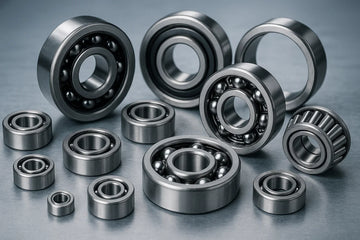A special performer capable of making everything go smoothly and accurately is embedded in the core of almost every rotating machine. A lot of modes of modern industrial success the performance of motors, wheels, fans, and engines hinge on a tiny but extremely important element of product that controls motion and uses minimum resistance. A closer look at the nature of functioning of this element unveils the genius in regards to the mechanical efficiency.
The Friction between the Moved Parts
Friction is that inherent force that opposes the sliding of two surfaces. In machines, too much friction apart from using more energy also causes heat production, wear and tear and shorter life span of parts. Getting rid of this friction is central to both automotive engine and heavy-duty industrial machine design.
When there is reduced friction, there is ease of operation, lesser maintenance and improved performance. It is at there that a clever idea occurs which would not eliminate friction, but would turn it into something easy and a minimal.
The Role of Rolling Elements in Minimizing Resistance
Rather than have surfaces to slide over one another, a good substitute is by having them roll. In a rolling state, the resistance is very minimal, as compared to the sliding. The principle is implemented with the help of rolling elements in-between moving components. Once confined with a definite structure, these rolling components happen to be what is called bearings.
The ball bearing is the most widely used and in this, it makes use of rolled balls to minimize direct surface contact among moving components.
How Ball Bearings Actually Work
The four main parts that comprise ball bearings include the inner race, outer race, balls and a cage which is used to ensure the balls are placed apart equally. The inner race is attached to the shaft and spins, where the outer race can be fixed or also move along with the housing. These two races roll the balls between them.
These are ways they assist in decreasing the friction:
- The spherical balls substitute the sliding motion by rolling motion since they operate by rolling. This enormously reduces the resistance experienced.
- This also decreases the friction since little contact surfaces are created between the balls and races. As a result, the rotation becomes smoother.
- The cage configuration causes the balls to be in an even spacing, they contribute to equal loading and eliminating jamming or misalignment.
The design helps create machines that are capable of high rotating speed at a low energy load and fewer heat generation.
Key Features That Enhance Efficiency
The reason why ball bearing is highly applicable in the industrial and mechanical fields is their accuracy in design and material properties. The superior bearing may be manufactured out of hardened steel or ceramic, resistant to the pressure and likely to have less deformation as the time goes by.
Furthermore, lubrication involves another crucial mechanism of minimizing mechanical friction even more. The purpose of grease or oil between the balls and races is to avoid an actual metal to metal contact and increases the life of the bearing as well.
Impact on Machinery Performance
Ball bearings are not merely related to the smooth rotation but it has a direct effect on the performance of equipments. They help by lessening the friction:
- Cycle power improvement
- Raise mechanical effectiveness
- Reduce heat-generated losses of energy
- Make it faster in terms of rotation speed
- Bear radial as well as axial loads
- Minimize the wear of the components, prolonging the life of the equipment
Due to these benefits, ball bearings are supplied in all kinds of machines including the ones in our house hold appliances, up to the ones in aerospace industries.
Comparison between Other Types of Bearings
Although ball bearings fit in many situations, they are not the only ones. An example is plain bearings, which use sliding motion and may be appropriate to high load/low-speed situations. They however tend to create more friction than ball bearing.
There is also a roller bearing type where the rolling elements are not spherical but cylindrical. These are more appropriate with heavy radial load. However, in regards to being fast, smooth and compactable, ball bearings offer the best compromise.
Supporting Modern Engineering with Precision
Robotic arms to electric motors, the need is there to incorporate ball bearings in the modern machinery as an evidence of their significance in the industrial development. Throwing large amounts of rotational forces, they create contact friction, which they minimize, which is invaluable in the modern engineering environment.
Their design has been retained by improving and perfecting materials, the coating and the use of lubrication technology to make them even more effective and with durability.
Moving and Moving on in all Revolutions
Bringing the ability to switch sliding to rolling, and dropping the mechanical friction, ball bearings run the performance of millions of machines quietly and reliably. They may be minor and yet their voice can be heard even in every effective turnover and fine-running system in all industries.





